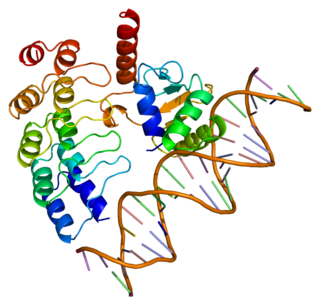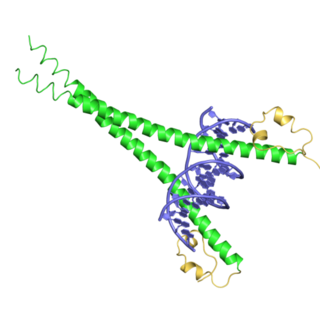
Activator protein 1 (AP-1) is a transcription factor that regulates gene expression in response to a variety of stimuli, including cytokines, growth factors, stress, and bacterial and viral infections. AP-1 controls a number of cellular processes including differentiation, proliferation, and apoptosis. The structure of AP-1 is a heterodimer composed of proteins belonging to the c-Fos, c-Jun, ATF and JDP families.

Nuclear factor erythroid 2-related factor 2 (NRF2), also known as nuclear factor erythroid-derived 2-like 2, is a transcription factor that in humans is encoded by the NFE2L2 gene. NRF2 is a basic leucine zipper (bZIP) protein that may regulate the expression of antioxidant proteins that protect against oxidative damage triggered by injury and inflammation, according to preliminary research. In vitro, NRF2 binds to antioxidant response elements (AREs) in the promoter regions of genes encoding cytoprotective proteins. NRF2 induces the expression of heme oxygenase 1 in vitro leading to an increase in phase II enzymes. NRF2 also inhibits the NLRP3 inflammasome.

Nuclear respiratory factor 1, also known as Nrf1, Nrf-1, NRF1 and NRF-1, encodes a protein that homodimerizes and functions as a transcription factor which activates the expression of some key metabolic genes regulating cellular growth and nuclear genes required for respiration, heme biosynthesis, and mitochondrial DNA transcription and replication. The protein has also been associated with the regulation of neurite outgrowth. Alternate transcriptional splice variants, which encode the same protein, have been characterized. Additional variants encoding different protein isoforms have been described but they have not been fully characterized. Confusion has occurred in bibliographic databases due to the shared symbol of NRF1 for this gene and for "nuclear factor -like 1" which has an official symbol of NFE2L1.

Activating transcription factor 4 , also known as ATF4, is a protein that in humans is encoded by the ATF4 gene.

Activating transcription factor 6, also known as ATF6, is a protein that, in humans, is encoded by the ATF6 gene and is involved in the unfolded protein response.

GA-binding protein alpha chain is a protein that in humans is encoded by the GABPA gene.

Kelch-like ECH-associated protein 1 is a protein that in humans is encoded by the Keap1 gene.

Transcription regulator protein BACH1 is a protein that in humans is encoded by the BACH1 gene.

Transcription factor Maf also known as proto-oncogene c-Maf or V-maf musculoaponeurotic fibrosarcoma oncogene homolog is a transcription factor that in humans is encoded by the MAF gene.

Hepatic leukemia factor is a protein that in humans is encoded by the HLF gene.

Transcription factor NF-E2 45 kDa subunit is a protein that in humans is encoded by the NFE2 gene.

Nuclear factor erythroid 2-related factor 1 (Nrf1) also known as nuclear factor erythroid-2-like 1 (NFE2L1) is a protein that in humans is encoded by the NFE2L1 gene. Since NFE2L1 is referred to as Nrf1, it is often confused with nuclear respiratory factor 1 (Nrf1).

CCAAT/enhancer-binding protein gamma (C/EBPγ) is a protein that in humans is encoded by the CEBPG gene. This gene has no introns.

Transcription regulator protein BACH2 is a protein that in humans is encoded by the BACH2 gene. It contains a BTB/POZ domain at its N-terminus which forms a disulphide-linked dimer and a bZip_Maf domain at the C-terminus.

Transcription factor MafK is a bZip Maf transcription factor protein that in humans is encoded by the MAFK gene.

Transcription factor MafF is a bZip Maf transcription factor protein that in humans is encoded by the MAFF gene.

Nuclear factor -like factor 3, also known as NFE2L3 or 'NRF3', is a transcription factor that in humans is encoded by the Nfe2l3 gene.

The Basic Leucine Zipper Domain is found in many DNA binding eukaryotic proteins. One part of the domain contains a region that mediates sequence specific DNA binding properties and the leucine zipper that is required to hold together (dimerize) two DNA binding regions. The DNA binding region comprises a number of basic amino acids such as arginine and lysine. Proteins containing this domain are transcription factors.

bZIP Maf is a domain found in Maf transcription factor proteins. It contains a leucine zipper (bZIP) domain, which mediates the transcription factor's dimerization and DNA binding properties. The Maf extended homology region (EHR) is present at the N-terminus of the protein. This region exists only within the Maf family and allows the family to recognize longer DNA motifs than other leucine zippers. These motifs are termed the Maf recognition element (MARE) and is 13 or 14 base pairs long. In particular, the two residues at the beginning of helix H2 are positioned to recognise the flanking region of the DNA. Small Maf proteins heterodimerize with Fos and may act as competitive repressors of the NF2-E2 transcription factor.
Small Maf proteins are basic region leucine zipper-type transcription factors that can bind to DNA and regulate gene regulation. There are three small Maf (sMaf) proteins, namely MafF, MafG, and MafK, in vertebrates. HUGO Gene Nomenclature Committee (HGNC)-approved gene names of MAFF, MAFG and MAFK are “v-maf avian musculoaponeurotic fibrosarcoma oncogene homolog F, G, and K”, respectively.






















